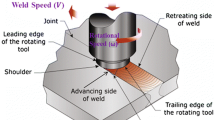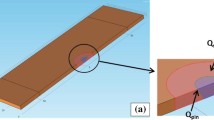Abstract
In this work, dissimilar butt joints of 6061 aluminum and 304 stainless steel were prepared by friction stir welding (FSW), and the FSW process is monitored by the infrared (IR) thermography. Considering the different material properties between aluminum and steel, a novel CFD model with weld tool is developed and tested to investigate the effects of weld tool on the aluminum-steel joint under different traverse speeds. The calculated temperature and thermal cycles for various traverse speed agreed well with the corresponding IR thermography experimental results. It is found that the calculated peak temperature is about 10 K lower than measured peak temperature and the relative error is 2.3%, while it is 11.4% for the model without weld tool. The model with weld tool can decrease the temperature gradient and inhomogeneity of temperature field for aluminum-steel joint. SEM analysis of the interface between aluminum and steel showed that the thickness of IMCs may decrease with traverse speed. The model with weld tool can provide calculated viscosity based on the validated temperature field to analyze the insufficient stirring defect of aluminum-steel joint.














Similar content being viewed by others
Data availability
The datasets generated and/or analyzed during the current study are available from the corresponding author on reasonable request.
Code availability
The codes used to reproduce this work cannot be shared at this time as they are part of an ongoing study.
References
Taban E, Gould JE, Lippold JC (2010) Dissimilar friction welding of 6061–T6 aluminum and AISI 1018 steel: properties and microstructural characterization. Mater Des 31(5):2305–2311
Hussein SA, Md Tahir AS, Hadzley AB (2015) Characteristics of aluminum-to-steel joint made by friction stir welding: a review. Mater Today Commun 5:32–49
Heidarzadeh A, Mironov S, Kaibyshev R et al (2021) Friction stir welding/processing of metals and alloys: a comprehensive review on microstructural evolution. Prog Mater Sci 117:100752
Bagheri B, Abbasi M, Sharifi F, Abdollahzadeh A (2022) Investigation into novel multipass friction stir vibration brazing of carbon steels. Mater Manuf Process 37(8):921–932
Bagheri B, Abbasi M, Sharifi F, Abdollahzadeh A (2022) Different attempt to improve friction stir brazing: effect of mechanical vibration and rotational speed. Met Mater Int 28:2239–2251
Bozzi S, Helbert-Etter AL, Baudin T, Criqui B, Kerbiguetc JG (2010) Intermetallic compounds in Al 6016/IF-steel friction stir spot welds. Mater Sci Eng, A 527(16–17):4505–4509
Wan L, Huang Y (2018) Friction stir welding of dissimilar aluminum alloys and steels: a review. Int J Adv Manuf Technol 99(5):1781–1811
Derazkola HA, Khodabakhshi F (2019) Intermetallic compounds (IMCs) formation during dissimilar friction-stir welding of AA5005 aluminum alloy to St-52 steel: numerical modeling and experimental study. Int J Adv Manuf Technol 100(9):2401–2422
Xiong JT, Li JL, Qian JW, Zhang FS, Huang WD (2012) High strength lap joint of aluminium and stainless steels fabricated by friction stir welding with cutting pin. Sci Technol Weld Joining 17(3):196–201
Wang TH, Sidhar H, Mishra RS, Hovanski Y, Upadhyay P, Carlson B (2018) Friction stir scribe welding technique for dissimilar joining of aluminium and galvanised steel. Sci Technol Weld Joining 23(3):249–255
Patterson EE, Hovanski Y, Field DP (2016) Microstructural characterization of friction stir welded aluminum-steel joints. Metall Mater Trans A 47(6):2815–2829
Nandan R, Debroy T, Bhadeshia HKDH (2008) Recent advances in friction-stir welding – process, weldment structure and properties. Prog Mater Sci 53(6):980–1023
He XC, Gu FS, Ball A (2014) A Review of Numerical Analysis of Friction Stir Welding. Prog Mater Sci 65(10):1–66
Su H, Wu CS, Bachmann M, Rethmeier M (2015) Numerical modeling for the effect of pin profiles on thermal and material flow characteristics in friction stir welding. Mater Des 77(15):114–125
Bagheri B, Abdollahzadeh A, Abbasi M, Kokabi AH (2020) Numerical analysis of vibration effect on friction stir welding by smoothed particle hydrodynamics (SPH). Int J Adv Manuf Technol 110:209–228
Bagheri B, Abbasi M, Abdolahzadeh A, Kokabi AH (2020) Numerical analysis of cooling and joining speed effects on friction stir welding by smoothed particle hydrodynamics (SPH). Arch Appl Mech 90:2275–2296
Sun Z, Wu CS (2020) Influence of tool thread pitch on material flow and thermal process in friction stir welding. J Mater Process Technol 275:116281
Chen GQ, Li H, Wang GQ et al (2018) Effects of pin thread on the in-process material flow behavior during friction stir welding: a computational fluid dynamics study. Int J Mach Tools Manuf 124:12–21
Chen GQ, Ma QX, Zhang S et al (2018) Computational fluid dynamics simulation of friction stir welding: a comparative study on different frictional boundary conditions. J Mater Sci Technol 34(1):128–134
Aziz SB, Dewan MW, Huggett DJ et al (2018) A fully coupled thermomechanical model of friction stir welding (FSW) and numerical studies on process parameters of lightweight aluminum alloy joints. Acta Metall Sinica-English Lett 31:1–18
Dialami N, Chiumenti M, Cervera M et al (2017) Enhanced friction model for friction stir welding (FSW) analysis: simulation and experimental validation. Int J Mech Sci 133:555–567
Chen GQ, Wang GQ, Shi QY et al (2019) Three-dimensional thermal-mechanical analysis of retractable pin tool friction stir welding process. J Manuf Process 41:1–9
Aziz SB, Dewan MW, Huggett DJ et al (2016) Impact of friction stir welding (FSW) process parameters on thermal modeling and heat generation of aluminum alloy joints. Acta Metall Sinica- English Lett 29(9):1–15
Miles MP, Nelson TW, Gunter C et al (2019) Predicting recrystallized grain size in friction stir processed 304L stainless steel. J Mater Sci Technol 35(4):491–498
Mirabzadeh R, Parvaneh V, Ehsani A (2021) Experimental and numerical investigation of the generated heat in polypropylene sheet joints using friction stir welding (FSW). IntJ Mater Form 14:1067–1083
Lee WB, Schmuecker M, Mercardo UA et al (2006) Interfacial reaction in steel–aluminum joints made by friction stir welding. Scripta Mater 55(4):255–358
FLUENT, Release 2019 R3 - © ANSYS, Inc. All rights reserved
Derazkola HA, Eyvazian A, Simchi A (2020) Submerged friction stir welding of dissimilar joints between an Al-Mg alloy and low carbon steel: Thermo-mechanical modeling, microstructural features, and mechanical properties. J Manuf Process 50:68–79
Yu ZZ, Zhang W, Choo H et al (2012) Transient heat and material flow modeling of friction stir processing of magnesium alloy using threaded tool. Metall and Mater Trans A 43:724–737
Chen GQ, Shi QY, Li YJ et al (2013) Computational fluid dynamics studies on heat generation during friction stir welding of aluminum alloy. Comput Mater Sci 79:540–546
Mills KC (2002) Recommended values of thermophysical properties for selected commercial alloys, Woodhead Publishing, pp 61-65 127-128
Ou W, Mukherjee T, Knapp GL et al (2018) Fusion zone geometries, cooling rates and solidification parameters during wire arc additive manufacturing. Int J Heat Mass Transf 127:1084–1094
Colegrove PA, Shercliff HR (2005) 3-Dimensional CFD modelling of flow round a threaded friction stir welding tool profile. J Mater Process Technol 169(2):320–327
Nandan R, Roy GG, Debroy T (2006) Numerical simulation of three-dimensional heat transfer and plastic flow during friction stir welding. Metall Mater Trans A 37(4):1247–1259
Sheppard T, Jackson A (1997) Constitutive equations for use in prediction of flow stress during extrusion of aluminum alloys. Metal Sci J 13(3):203–209
Tello KE, Gerlich AP, Mendez PF (2010) Constants for hot deformation constitutive models for recent experimental data. Sci Technol Weld Joining 15(3):260–266
Chen GQ, Feng ZL, Zhu YC et al (2016) An alternative frictional boundary condition for computational fluid dynamics simulation of friction stir welding. J Mater Eng Perform 25:4016–4023
Bagheri B, Abbasi M, Abdollahzadeh A (2021) Microstructure and mechanical characteristics of AA6061-T6 joints produced by friction stir welding, friction stir vibration welding and tungsten inert gas welding: A comparative study. Int J Miner Metall Mater 28:450–461
Abdollahzadeh A, Bagheri B, Abassi M et al (2021) Comparison of the Weldability of AA6061-T6 Joint under Different Friction Stir Welding Conditions. J Mater Eng Perform 30:1110–1127
Mundra K, Debroy T, Kelkar2 KM (1996) Numerical prediction of fluid flow and heat transfer in welding with a moving heat source. Numer Heat Transf, Part A: Appl 29(2):115–129
Funding
This work was supported by the Natural Science Fund for Colleges and Universities in Jiangsu Province (20KJB460013).
Author information
Authors and Affiliations
Contributions
Wenmin Ou and Guolin Guo conceived and designed the study. Chenshuo Cui and Yaocheng Zhang performed the experiments. Longgen Qian and Wenin Ou established the model. Wenmin Ou and Guolin Guo reviewed and edited the manuscript. All the authors read and approved the final manuscript.
Corresponding author
Ethics declarations
Ethics approval
Not applicable.
Consent to participate
Not applicable.
Consent for publication
The author confirms that the work has not been published before; that it is not under consideration for publication elsewhere that its publication has been approved by all co-authors; that its publication has been approved by the responsible authorities at the institution where the work is carried out.
Competing interests
The authors declare that they have no competing interests.
Additional information
Publisher's note
Springer Nature remains neutral with regard to jurisdictional claims in published maps and institutional affiliations.
Rights and permissions
Springer Nature or its licensor (e.g. a society or other partner) holds exclusive rights to this article under a publishing agreement with the author(s) or other rightsholder(s); author self-archiving of the accepted manuscript version of this article is solely governed by the terms of such publishing agreement and applicable law.
About this article
Cite this article
Ou, W., Guo, G., Cui, C. et al. Heat transfer in aluminum-steel joint and weld tool during the friction stir welding: Simulation and experimental validation. Int J Adv Manuf Technol 125, 2211–2224 (2023). https://doi.org/10.1007/s00170-023-10889-1
Received:
Accepted:
Published:
Issue Date:
DOI: https://doi.org/10.1007/s00170-023-10889-1




